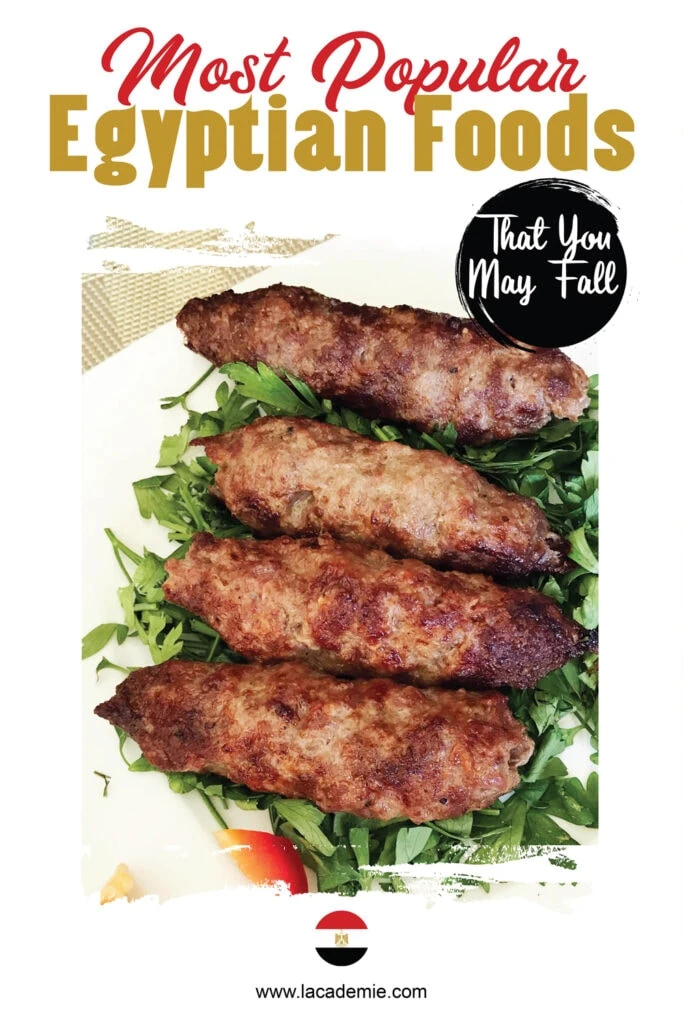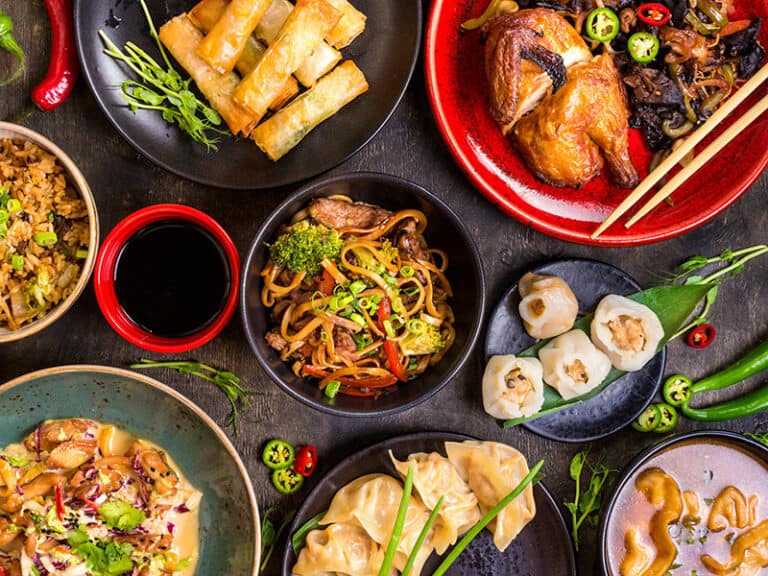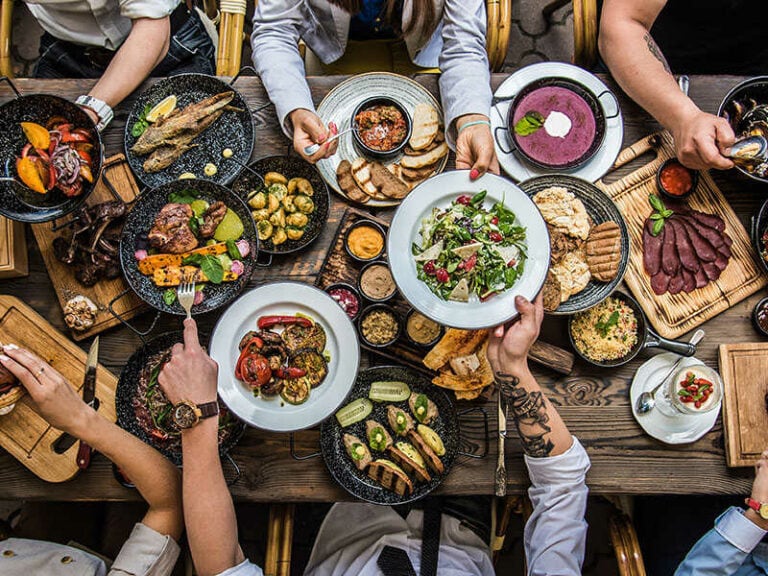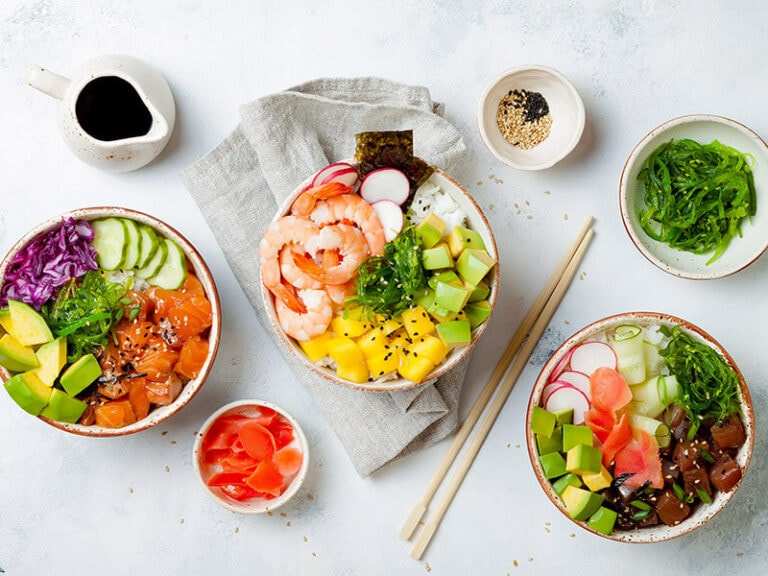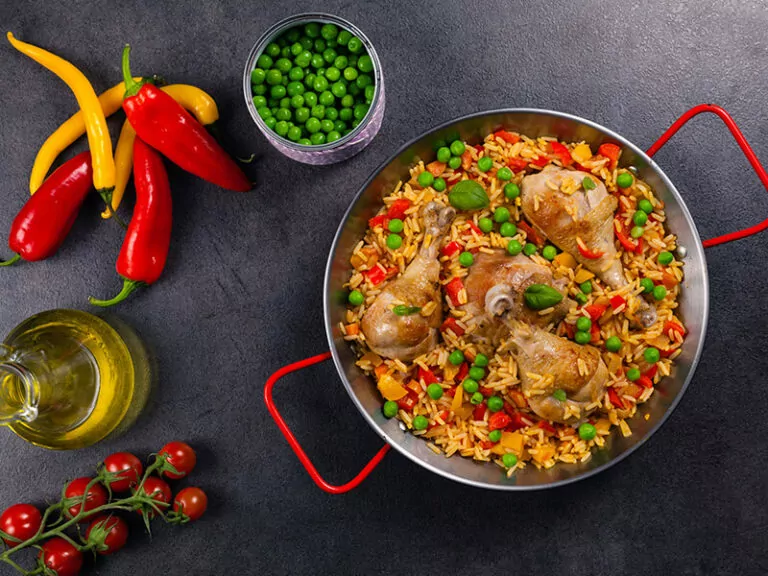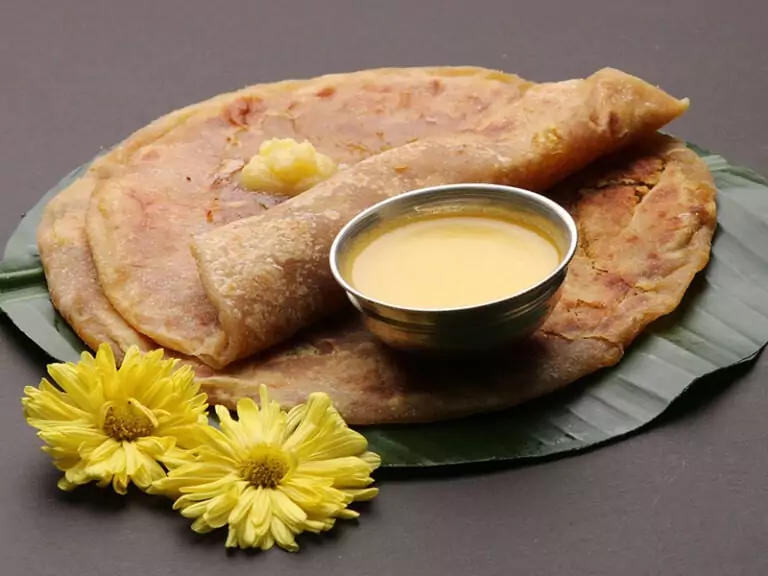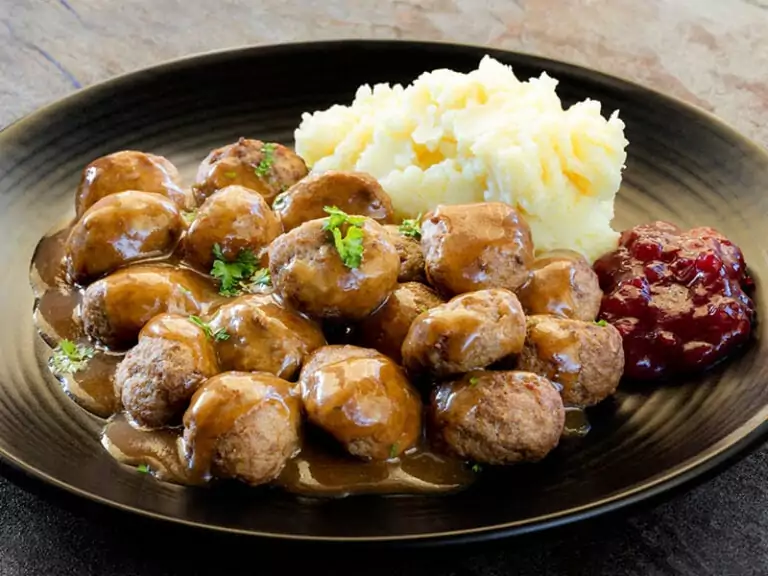Egyptian foods may not be popular worldwide, since Egypt’s reputation has lied into the Pyramids, geometric shapes, and numbers. However, if you explore more about them, you may find that the foods are also one of the spotlights of Egypt!
Since they are not that popular, many people may think that the Egyptian recipes are plain and not really good. But it is an incorrect assumption! Their cuisine is super delicious with various dishes, from morning till dawn.
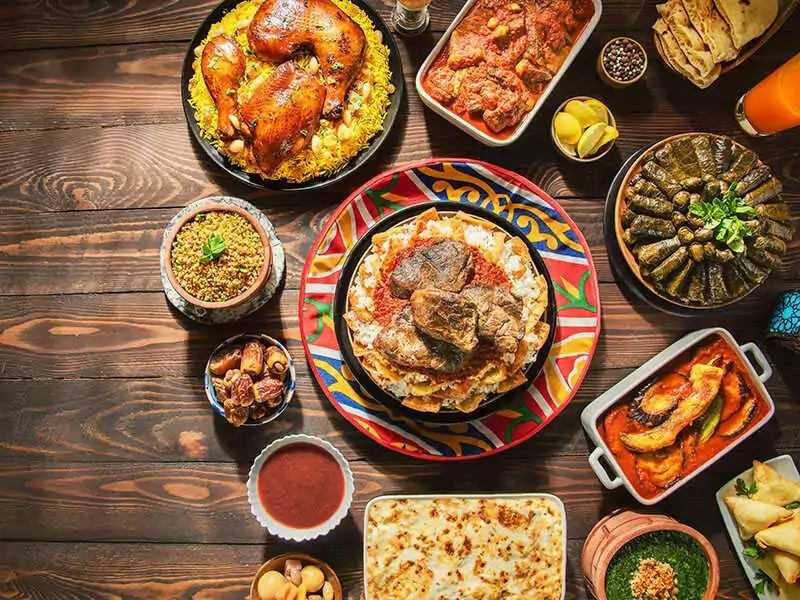
The Wonders of Egyptian Cuisine
Let’s explore the enchanting dishes that have nourished pharaohs and inspired food lovers for millennia.
History
Egyptian cuisine has a rich history that dates back over 3,000 years. It has been influenced by the culinary traditions of neighboring regions, such as Persia, Greece, and Rome, as well as the Mediterranean, Africa, and the Middle East.
Ancient Egyptians relied heavily on agriculture and fishing to sustain their diet, and many traditional dishes are still enjoyed today.
Influence Of Geography, Climate, And Culture
Egypt’s geography, with its fertile Nile Valley, desert regions, and access to the Mediterranean and Red Seas, has significantly impacted its culinary traditions.
The fertile land along the Nile River allowed for the cultivation of a variety of crops, while the desert climate influenced the preservation techniques and the use of dried and salted foods.
Cultural and religious beliefs, such as the importance of vegetarian dishes during Coptic Christian fasting periods, have also shaped Egyptian food choices.
Importance of Traditional Egyptian Foods In Modern Times
In modern times, traditional Egyptian foods remain an essential part of the country’s cultural identity. They connect Egyptians to their history and bring families together during meals and celebrations.
As Egypt becomes increasingly globalized, preserving and promoting traditional cuisine has become even more critical in maintaining a sense of national pride and heritage.
Staple Ingredients
Delve into the staple ingredients that have brought Egyptian dishes to life for thousands of years.
- Grains: Wheat, barley, and rice form the foundation of many Egyptian dishes, providing energy and sustenance.
- Vegetables: Onions, tomatoes, and bell peppers are prevalent in Egyptian cooking, adding color, flavor, and nutrition to a wide array of dishes. Other commonly used vegetables include okra, eggplant, and leafy greens.
- Legumes: Lentils, chickpeas, and fava beans are popular sources of plant-based protein in Egyptian cuisine. These versatile legumes are used in numerous dishes, from stews and soups to salads and spreads.
- Proteins: Poultry, fish, and meat (lamb and beef) play a significant role in Egyptian cuisine. While vegetarian dishes are abundant, meat-based dishes are also highly valued, especially for special occasions and celebrations.
- Spices: Cumin, coriander, and cinnamon are essential spices in the Egyptian pantry, lending depth and complexity to a variety of dishes. Other commonly used spices include allspice, nutmeg, and paprika.
Contemporary Egyptian Cuisine
Discover how time-honored traditions blend seamlessly with modern influences, creating an irresistible fusion of flavors that continues to captivate food enthusiasts around the world.
Fusion With International Cuisines
As Egypt becomes more globalized, its cuisine has evolved to incorporate international flavors and techniques.
For example, Italian, French, and Asian influences can be found in modern Egyptian dishes. This fusion has led to the creation of unique, innovative recipes that celebrate both the traditional and the new.
Adaptation Of Traditional Dishes For Health-Conscious Diets
In response to the growing trend of health-conscious eating, many Egyptian chefs and home cooks have adapted traditional recipes to cater to various dietary needs.
This includes incorporating more whole grains, reducing added sugars, and using healthier cooking methods, such as grilling or baking instead of frying.
Vegetarian and vegan versions of classic dishes are also becoming more popular, allowing for a broader range of dietary preferences.
Vegetarian Dishes
Egyptian cuisine provides plenty of vegetarian dishes that are both flavorful and satisfying. Rich in legumes, vegetables, and grains, these dishes showcase the region’s agricultural bounty and cater to diverse palates.
1. Ta’ameya
(Falafel)
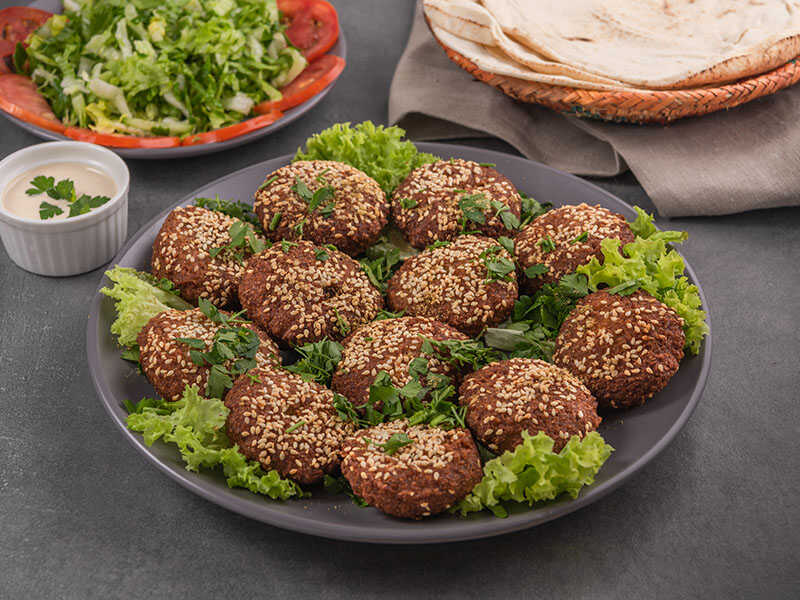
A scrumptious culinary adventure awaits with the traditional Egyptian delight, Falafel, a deep-fried fritter with an intriguing history. This classic dish, also known as Ta’ameya, holds a revered place in Egyptian cuisine, alongside famous dishes like Koshari and Ful Medames.
The falafel’s origin is a subject of much debate, with some tracing its roots to Egypt’s Coptic Christians in the Roman era, who allegedly consumed a fava bean version during Lent as early as the 4th century.
This mouthwatering street food from the bustling streets of Cairo, a staple in the Levant, is believed to have emerged in Alexandria, Egypt’s principal port city. It was here that the first falafel was born.
Nowadays, it’s enjoyed across the Middle East, with most regions opting for ground chickpeas. However, Egypt’s falafel remains unique with its core ingredient of dried fava beans, creating a lighter, more moist texture, and a vibrant green interior due to the generous use of herbs.
Egyptian falafel is not only a breakfast favorite but also a popular choice during Ramadan, often included in the iftar meal that breaks the fast after sunset. This versatile fritter can be savored on its own or as part of a larger mezze platter.
Try stuffing it into a pita like a sandwich, accompanied by tomatoes, onions, lettuce, tahini sauce, and a dash of hot sauce for an extra kick. Egypt’s love affair with fava beans, showcased in dishes like Ful Medames and Falafel, reflects a profound connection to the nation’s culinary identity.
Food historian Ken Albala suggests that consuming fava beans is a “conscious act of nationalism” in Egypt, a way to remember who they are amid the contemporary food landscape.
2. Kushari – Egyptian National Dish
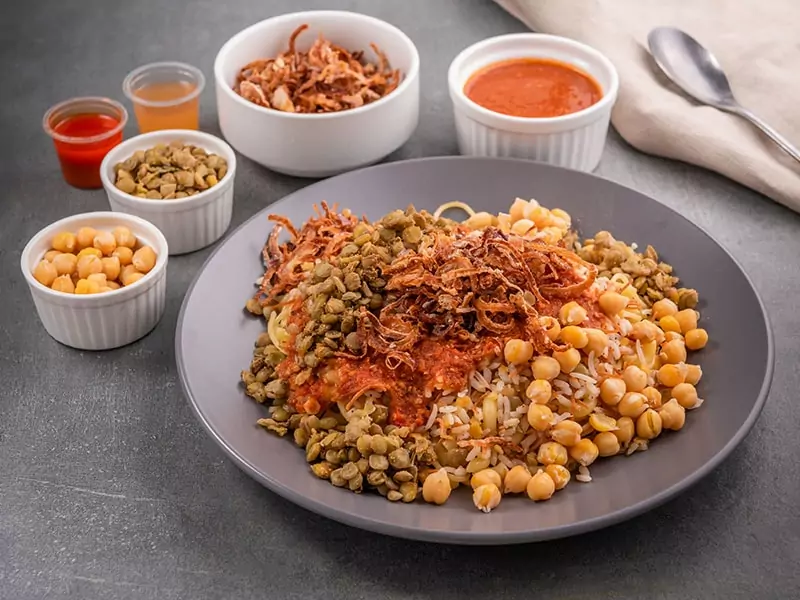
Experience the rich flavors of Egypt with the renowned and mouthwatering dish, Koshary (commonly referred to as Kushari or Koshari).
A concoction of white rice, lentils, macaroni, chickpeas, fried onions, and a tangy garlic-vinegar tomato sauce, Koshary’s unique blend of flavors and textures has cemented its status as a national dish.
Ideal for mass catering events, such as conferences, this hearty dish has become synonymous with Egyptian lunch recipes. Its high carb content makes it a perfect source of energy and sustenance, especially for workers and laborers.
Interestingly, the widespread appeal of Koshary has led to various adaptations in Eastern Arabia and Yemen, further testament to its irresistible taste.
Koshary’s origin dates back to mid-19th century Egypt, where it emerged as a resourceful way to utilize leftover pantry staples. Initially sold from street carts and popular among laborers, Koshary eventually found its way into restaurants, where it now reigns as one of Egypt’s most beloved comfort foods.
3. Aish Baladi
(Flatbread)
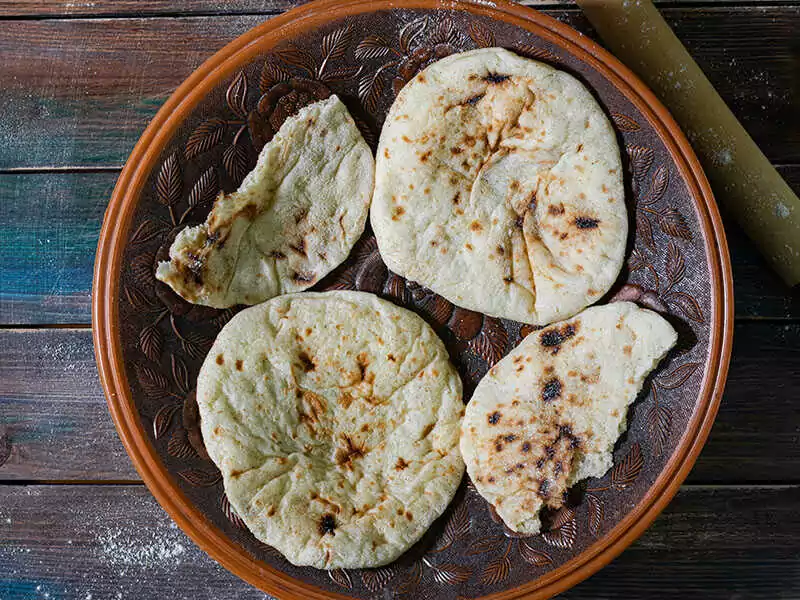
Bread is an important part of Egyptian cuisine – they cannot live without it! And this flatbread is so tasty that I’m sure you’ll be amazed! It is similar to pita, a dish commonly seen in the Middle East, but Egyptians make it from 100% whole wheat flour and bake it in an extremely hot oven.
Aish Baladi has appeared in Egypt from more than 5000 years ago in Ancient Egypt. The bread back then was made of an ancient type of wheat called “Emmer,” or barley, a nutritious ancient grain.
Wild yeast contributes to the dough rising before it is baked in classic Egyptian clay ovens. This age-old technique has been inherited across generations, cementing Aish Baladi’s position as a fundamental culinary element.
The name Aish Baladi itself highlights its importance to Egyptian culture, with “Baladi” meaning “traditional” or “genuine,” and “Aish” signifying “life.”
This cherished bread is enjoyed by Egyptians from all socioeconomic backgrounds, representing a crucial aspect of their daily nourishment. In Cairo, this fundamental flatbread is baked multiple times per day to ensure that everyone has access to fresh bread during meals.
4. Hummus
(Egyptian Mashed Chickpeas)
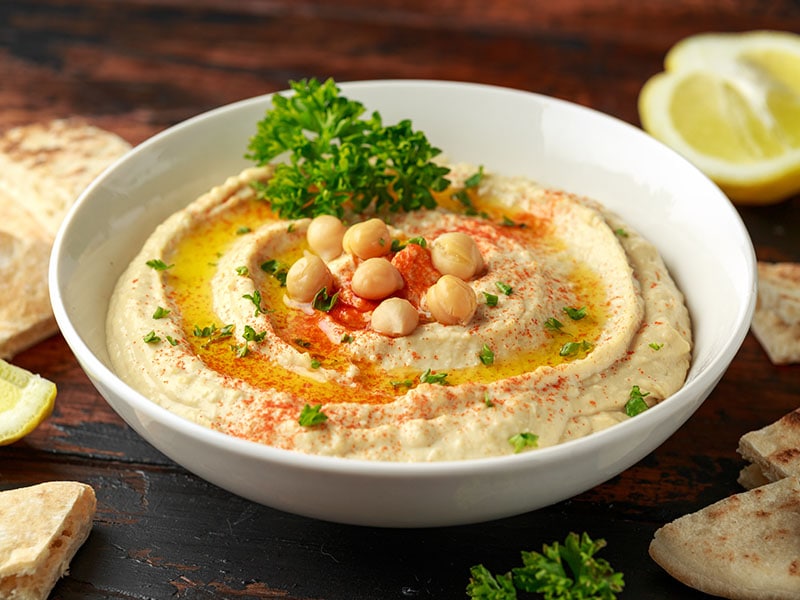
Hummus is a delectable dip made from mashed chickpeas with other ingredients such as olive oils, garlic, parsley, cumin, tahini, paprika, etc. Due to its complex ingredient, there’s no surprise that hummus has a very distinct and unforgettable taste.
You can say that hummus is a super famous savory dish in Middle Eastern rich cuisine. There are different unofficial claims on the origin of Hummus, but a similar recipe showed up in cookbooks from 13th-century Cairo.
Hummus is popular in Egypt and across the Middle East. The name “hummus” translates to “chickpeas” in Arabic, while the dish’s full title, ḥummuṣ bi ṭaḥīna, means “chickpeas with tahini.”
Typically, hummus is served as an appetizer or a side, frequently paired with falafel or as part of a mezze platter. Pita bread is also the go-to accompaniment for hummus.
Interestingly, historical records reveal that a different version of hummus, known as hummus kasa, was enjoyed by Egyptians during the 13th and 14th centuries. This variation, meaning “crushed hummus,” featured a chunkier consistency and included coarsely chopped nuts for added texture and taste.
In contemporary Egypt, it can be found in various settings, from restaurants and street food vendors to home kitchens.
5. Mahshi
(Stuffed Vegetables)
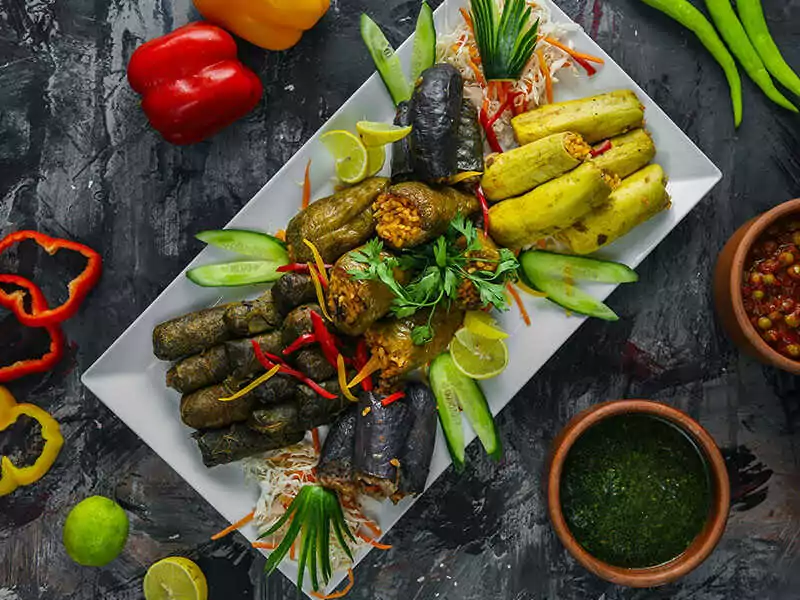
With deep Ottoman roots, Mahshi has journeyed across the vast expanse of the ancient empire, finding its way from the Balkans to Egypt and the Levant.
Mahshi, also called Mashi or Mashy, is a green dish including many vegetables such as eggplants, zucchini, bell peppers, cabbage, tomatoes, etc., stuffed with a unique filling. The filling contains mainly rice, herbs, spices, tomato sauce, and cinnamon.
This dish can be a seasonal one since the main ingredients will change according to the seasons in a year. For instance, the cook will use vine leaves in the summer and cabbage in the winter to make Mahshi.
As a prominent feature in Egyptian feasts, Mahshi particularly shines during Ramadan, when loved ones congregate for iftar at dusk to break their fast together.
6. Baba Ghanoush
(Spoiled Dad Dip)
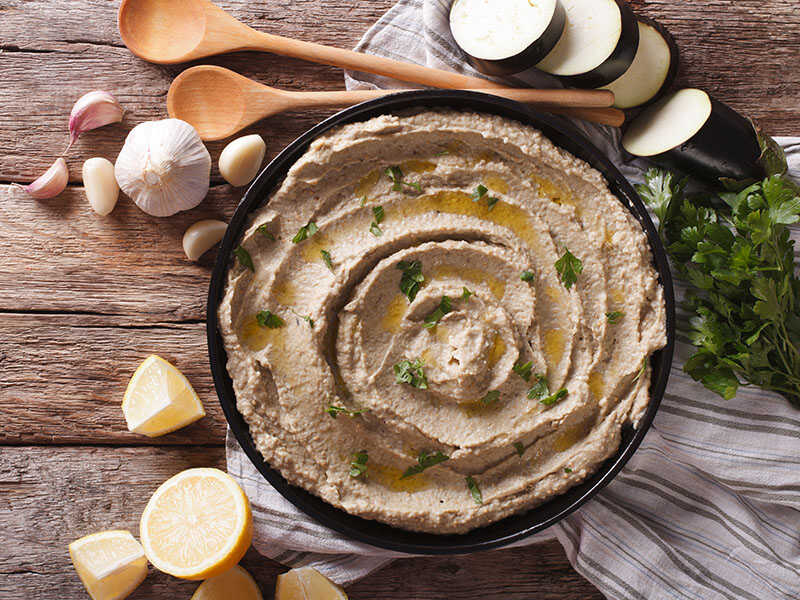
Baba Ghanoush, or Baba Ghanouj, is a famous dip originating from Lebanon. This scrumptious food beginning with “B” is somehow similar to Hummus, with eggplant as the primary ingredient. It also includes olive oil, garlic, lemon juice, and other herbs and spices like Hummus.
To make this dip, the cook will roast eggplant directly over an open fire, then peel its skin and mix with other components. Egyptians typically serve it cold as a part of a mezze platter or a side dish. You may find it on a dinner table when you visit this country.
There is a dish that bears a striking resemblance to baba ghanoush – Mutabbal, which is often regarded as its zestier counterpart.
This flavorful creation has various interpretations, such as babaganuş or abugannuş in Turkey, and mutabal in Armenia. In Syria, a distinctive twist involves blending the dish with sheep cheese, enriching the culinary experience.
7. Ful Medames
(Bean Stew)
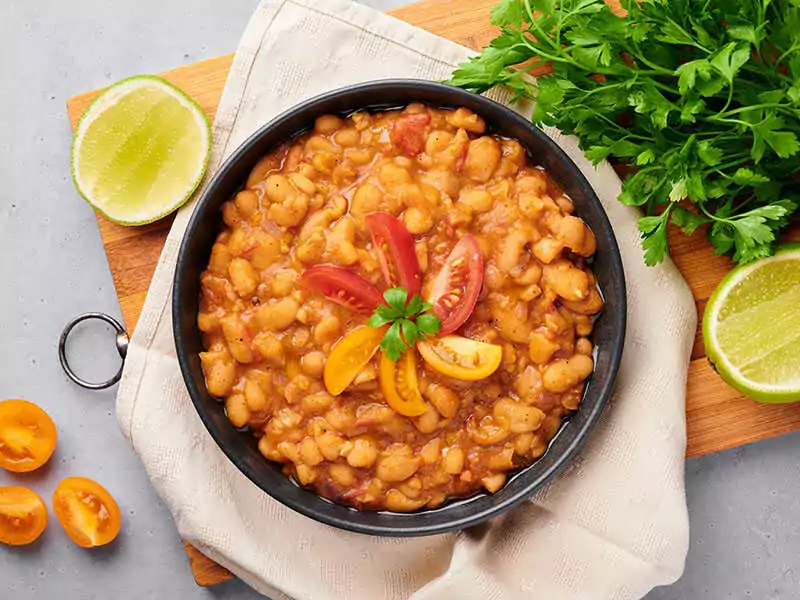
Step into the Middle Ages when crafting fava beans for ful medames was a distinct activity for those residing near the Princess Baths in Cairo. Adjacent to the Mosque of Sultan al-Muayyad, this public bath gave birth to an Egyptian national dish that remains cherished today.
Bath attendants utilized the fires that heated the enormous bathwater pots, called qidras, to create a culinary innovation. They simmered fava beans in the qidras overnight and then sold the appetizing beans the next morning.
Before stewing the fava beans for hours with oil and salt, Egyptians diligently soak them overnight. This vegetarian-friendly dish is loaded with nutrients such as carbohydrates and iron, while keeping saturated fats to a minimum.
Ful medames, also known as foul mudammas, is a flavorful stew made from fava beans expertly cooked with spices, cumin, garlic, lemon juice, olive oil, and herbs.
This dish’s fame has expanded beyond Egypt’s borders, reaching tables in the Levan, North Africa, and Middle East. Like aish baladi, ful medames is a versatile meal you can savor during a late breakfast, lunch, and dinner.
It is often compared to baba ganoush and hummus. And it is usually enjoyed as a dip for warm pita bread. Although traditionally prepared with fūl ḥammām (bath beans), other fava bean varieties, such as fūl baladī (country beans) or fūl rūmī (European broad beans), can also be used for ful medames.
8. Mulukhiyah or Molokhia
(Green Slimy Soup)
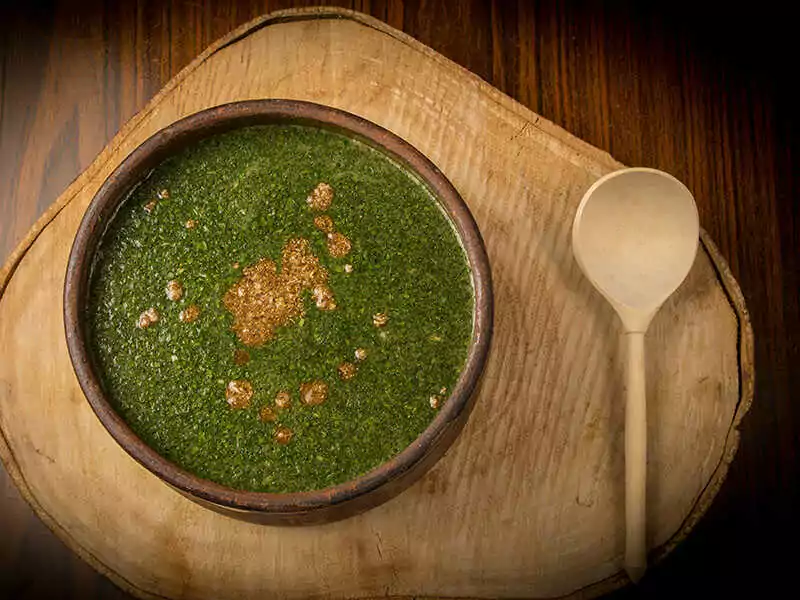
Molokhia is an Egyptian national dish with a storied history dating back to Ancient Egypt. Made from the leaves of the Corchorus plant or jute mallow, this leafy vegetable takes center stage in a soup that has become an integral part of Egyptian cuisine.
Boiling the leaves in beef or chicken broth, garlic, and a medley of seasonings, Molokhia is a beloved dish among Egyptians who have cherished it since childhood. Mothers often incorporate Molokhia into their children’s daily meals, using it as a means to introduce new vegetables to their young ones.
Known for its slightly slimy texture, akin to that of okra, this classic Egyptian comfort food has expanded beyond its borders, finding its way into the cuisines of Tunisia, Haiti, Kenya, and the Philippines.
Served with rice or Egyptian flatbread, Molokhia is often paired with various meat dishes such as seafood, roasted chicken, or rabbit.
Meat & Seafood Dishes
The meat and seafood dishes of Egypt are a testament to the country’s diverse culinary heritage and the influence of neighboring regions.
9. Hamam Mahshi
(Stuffed Squab)
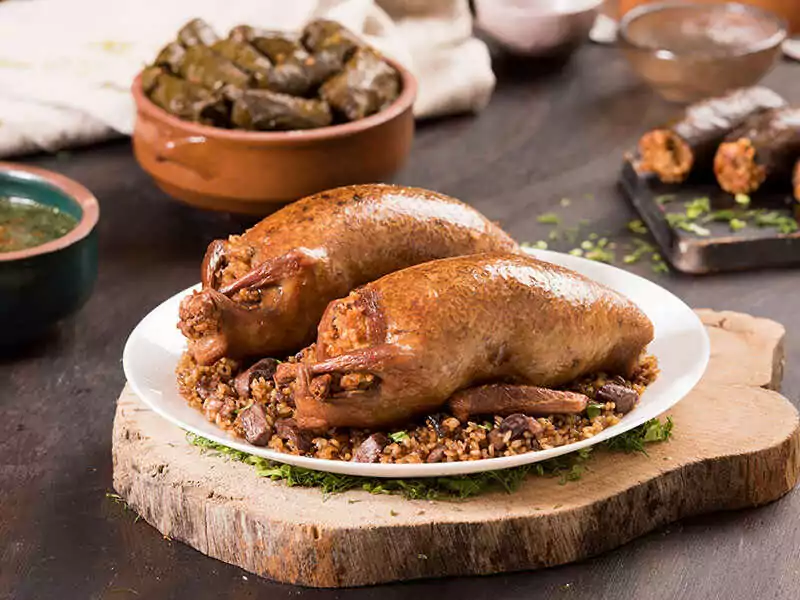
Hamam Mahshi is an ancient dish that Egyptians have eaten for centuries. It includes squab (small pigeon) stuffed with freekeh, onions, and seasonings.
Freekeh is a kind of Egyptian cracked wheat that’s also a famous dish in Palestine, Syria, Tunisia, Turkey, and more. The cook can substitute this wheat with bulgur wheat or rice in this dish.
The history of Hamam Mahshi stretches back to ancient Egypt, when pigeons were considered a delicacy and reserved for special occasions and festivals. Fast forward to today, and this exquisite dish can be found gracing the tables of Egyptian homes and restaurants, showcasing its enduring popularity.
While pigeons may be perceived as mere pests in certain cities, in Egypt, they are a celebrated gourmet ingredient. Raised in dovecotes, mother pigeons nourish their young with a nutrient-rich secretion called crop milk.
Egyptians will pick those fattest squabs about 6 weeks old to cook Hamam Mahshi. It is the most appropriate age of a squab for the best meat quality. If they are older, the meat may become too tough and chewy that is not in the best condition for cooking.
Pigeons seem to be a rare type of meat, but Egyptian villagers along the Nile River have been raising them for a long time! They usually serve Hamam Mahshi on special occasions such as weddings, but you can always find it in a traditional Egyptian restaurant if you visit Egypt.
10. Macarona Béchamel
(Egyptian Baked Pasta)
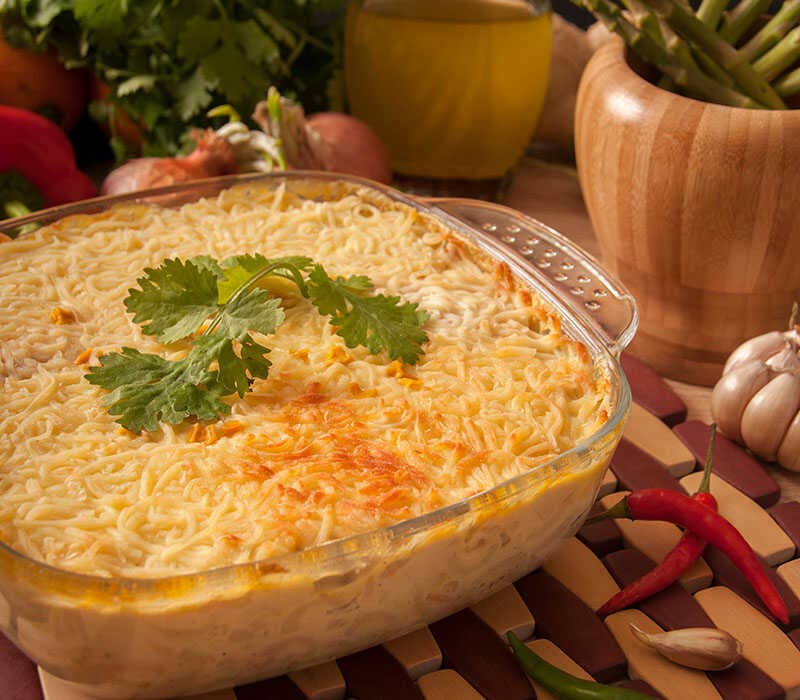
This Macarona Béchamel (or Makarōna beshamel) dish is a treat from heaven with three filling layers of casserole. The deepest layer includes boiled Penne pasta. The middle layer is usually beef mixed with tomato sauce and some onions. The top of it is white Béchamel sauce.
Although Macarona Béchamel may not seem like a typical Egyptian dish at first glance, it holds a special place in the nation’s cuisine. In Egyptian Arabic, the name “Makarōna beshamel” translates to “macaroni with Béchamel”.
Introduced to Egypt by Greek and Italian immigrants in the 19th century, Macarona Béchamel has since become a cherished comfort food in Egyptian cuisine.
Macarona Béchamel will be ready when its top layer turns golden brown in the baking process. This dish is an all-occasion food and is perfect to feed the crowd! If you are going to visit Egypt with your family, don’t hesitate to call this dish for a remarkable dinner!
11. Shawarma
(Egyptian Sandwiches)
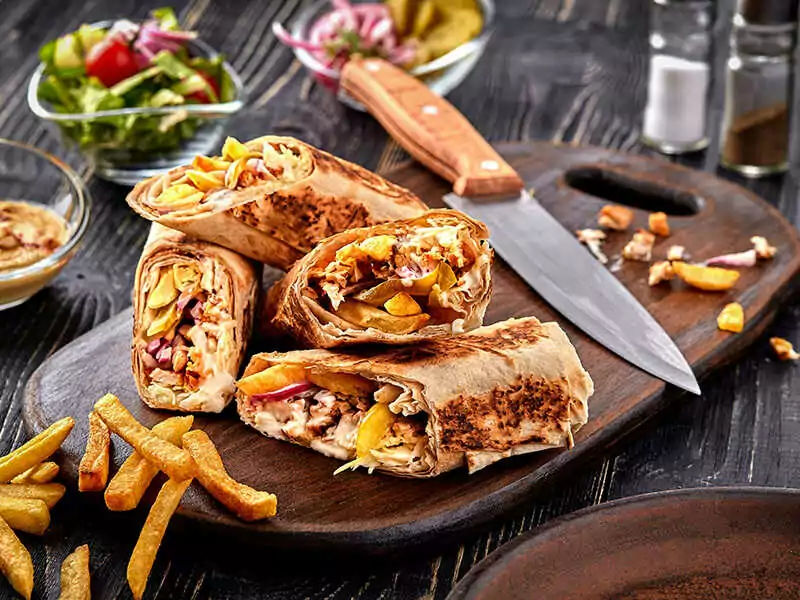
This scrumptious delight has captured the hearts of foodies in Cairo, Egypt, and far beyond the borders of the Middle East. Its irresistible charm even made a cameo in an iconic Avengers post-credit scene!
Shawarma originates from Greek gyros, but the Egyptians have turned it into their unique edition. It will be a great street food option for those visiting Egypt for the first time!
You can also easily spot Shawarma in many other countries in the Middle East as well. To name one example, among the list of must-try Lebanese dishes, you’ll easily see Chicken Shawarma.
The tantalizing flavors arise from the thin, heavily-spiced slices of meat – be it beef, lamb, chicken, or mutton – pierced and assembled onto a vertical skewer.
With larger pieces layered on top, a captivating cone-like stack, nearly 20 inches high, comes to life. A motorized spit then works its magic, rotating the stack against a vertical heating element, which slowly roasts the meat to perfection in its own juices and fat.
The shawarma experience becomes complete when these succulent pieces of meat are served in pita bread as a pocket sandwich or wrap, accompanied by an orchestra of flavors: onions, french fries, cucumbers, tomatoes, hot sauce, and tahini sauce.
12. Kebab and Kofta
(Egyptian Meatballs)
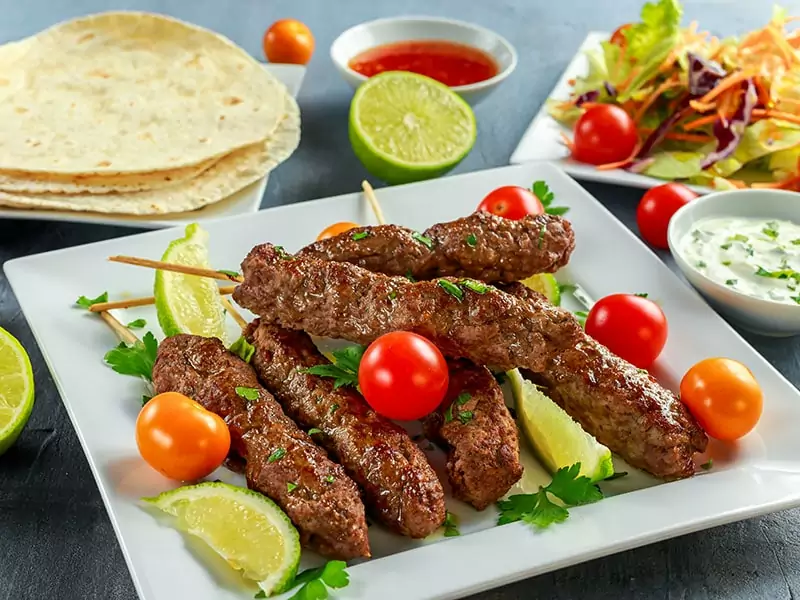
A heavenly union between two of the most delicious dishes ever created – kebab and kofta. Kebab is known for its tender pieces of meat, grilled to perfection on a coal fire, and typically paired with rice, vegetables, or bread.
In this divine culinary fusion, kebab meets its match with kofta, an Egyptian specialty featuring sausages made from minced lamb or beef, seasoned with a unique blend of spices.
Far from being a meat overload, this Egyptian rendition of meatballs provides a refreshing touch with the accompaniment of salads, such as chopped cucumber and tomato.
Kofta, also known as kefta, belongs to meatball or meatloaf dishes celebrated across the Mediterranean, Levant, North Africa, the Indian subcontinent, and the Balkans.
These versatile delicacies are typically crafted from various seasoned ground meat varieties, but their adaptability extends to other ingredients, such as vegetables and fish. Kofta can take on multiple forms, such as patties, balls, cigars, and be prepared in a multitude of ways.
Enter the world of kofta kebabs, where skewered and grilled koftas take center stage. The recipe may vary, but the essence lies in a harmonious blend of ground beef and lamb, accompanied by onions, garlic, and a medley of herbs and spices, including parsley, paprika, mint, nutmeg, cardamom, sumac, cumin, and allspice.
Once the meat mixture is skillfully molded over skewers, it’s grilled to perfection, each side cooked for about four minutes. The final product, a delight to the senses, can be enjoyed with white rice or pita bread and served alongside a variety of sides, salads, and dips.
13. Fattah (White Rice, Meat, Pita Bread, and Sauce)
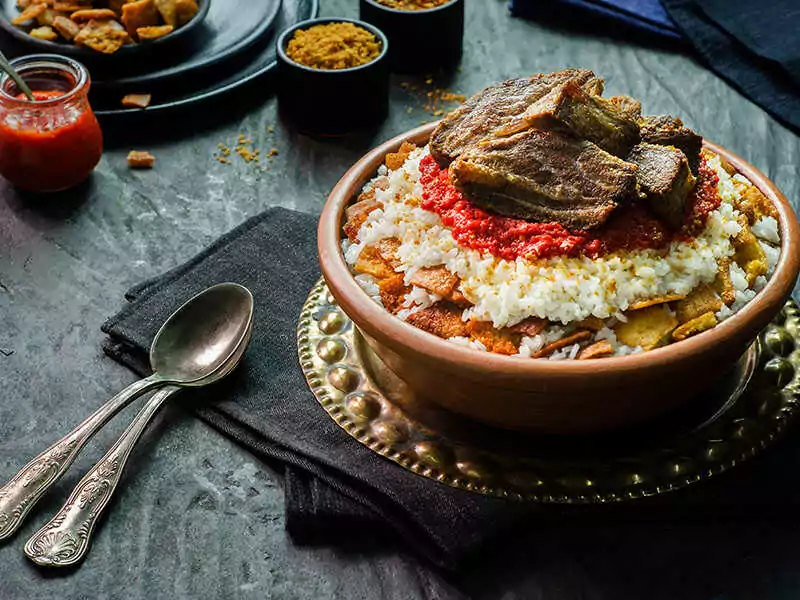
Fattah in Arabic means “crumbs” or “crushed.” So, the dish includes a lot of flatbread pieces dipped in various components, which may vary but usually are rice, lamb, and garlic tomato or vinegar sauce in the Egyptian edition. It is a simple yet delicious festive food!
Fattah is a shared dish of many nations in the Middle East, especially in the Levant areas. As such, don’t be surprised to see it appear in the must-try food list of UAE, Lebanon, Palestine, and more.
Back to those ancient days of Egypt, Fattah often showed up on important celebrations of Egyptians, such as weddings or the birthday of a newborn. Nowadays, it is one of the main dishes on the table on the first day of Eid al-Adha, an Islamic festival held in July.
14. Bamya
(Okra Stew)
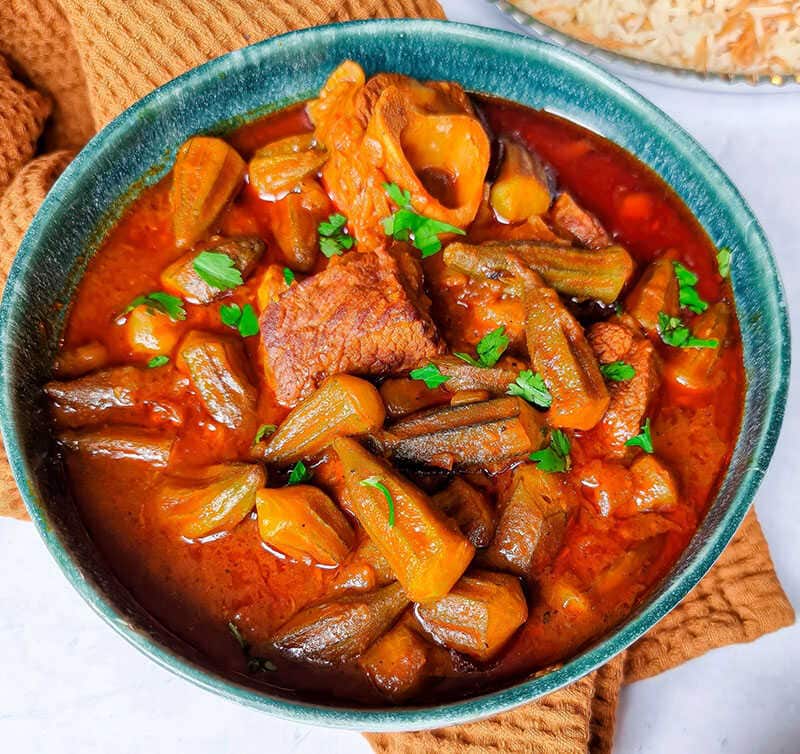
Bamya is a flavorsome Egyptian stew that has captured the hearts of food enthusiasts throughout the Mediterranean and Levant regions. This dish features okra, the star ingredient, and tender lamb immersed in a rich tomato sauce.
Infused with onions, garlic, peppers, cilantro, and a medley of spices, Bamya is a true delight for the senses. This scrumptious stew, whose name means “okra” in Arabic, showcases the versatility of Egyptian cuisine with its numerous variations.
Though traditionally made with meat, Bamya can also be prepared without it, catering to diverse dietary preferences. Regardless of the version, a hearty serving of protein, such as lamb or beef, elevates this dish to new heights.
Bamya pairs perfectly with white rice or pita bread, providing a satisfying meal that leaves you craving more. To further enhance the flavors, add a squeeze of lemon for a tangy twist.
15. Mombar
(Stuffed Beef Sausage)
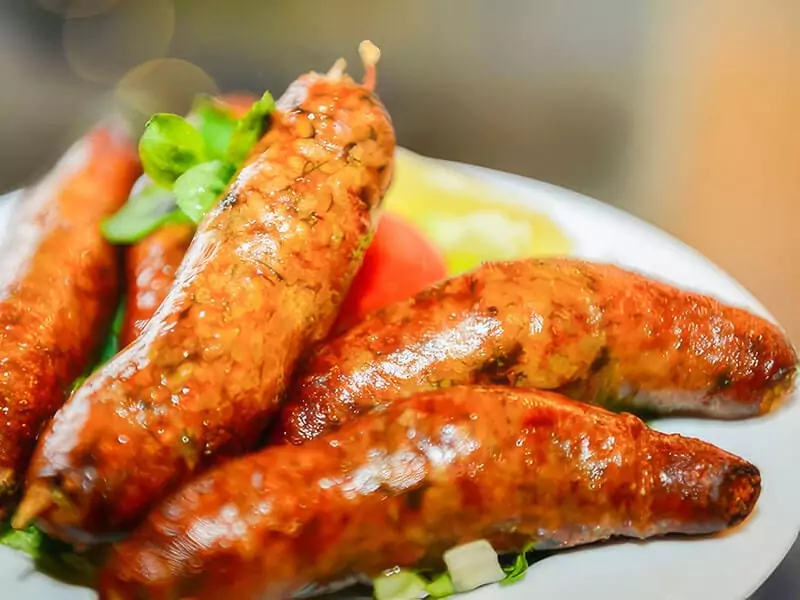
Feast your senses on Mombar, a succulent Egyptian sausage that has charmed the palates of food aficionados throughout the Middle East and North Africa. Made from sheep intestines, this gastronomic gem is a beloved component of the culinary traditions of Egypt, Tunisia, Libya, Syria and Algeria.
The creation of Mombar involves stuffing sheep casings with an enticing combination of ground beef, garlic, onions, rice, tomato paste, and various seasonings.
Each rendition of this dish features its distinct blend of herbs and spices, often highlighting the likes of cilantro, parsley, coriander, cumin, and cinnamon. After being prepared, these sausages are first boiled in water and subsequently fried to achieve a perfect golden brown exterior.
Mombar goes by different names in different regions, such as qubawat in Syria, palsin in Lebanon and Palestine, and usban in Libya, each bearing its unique local flair. A close relative to Mombar in North African cuisine is merguez, a similar sausage that omits the use of rice.
16. Kebda Eskandarani
(Liver Sandwich)
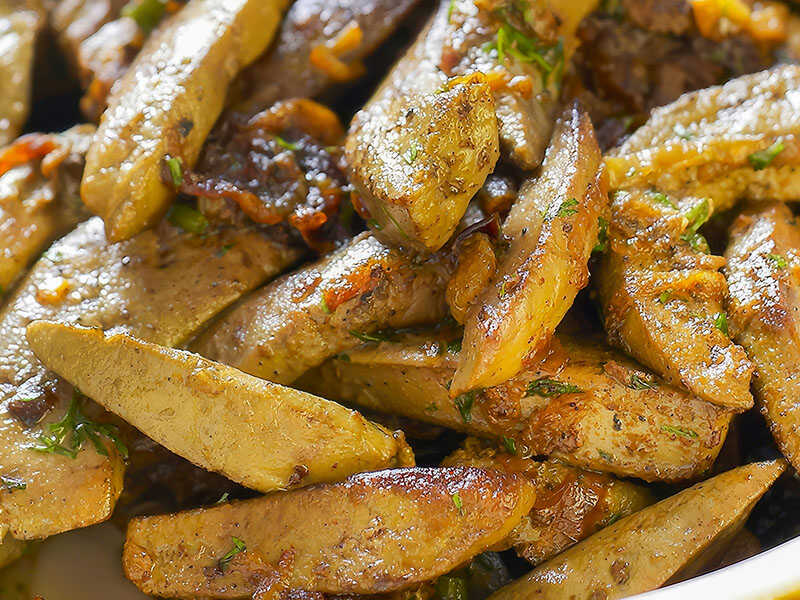
Kebda Eskandarani, a traditional Egyptian delicacy that tantalizes taste buds with its harmonious blend of flavors. Hailing from the bustling streets of Alexandria, this fried beef liver dish is seasoned with an enticing combination of chili peppers, garlic, cardamom, and cumin.
This Alexandrian specialty is not only a popular street food but also a versatile dish that can be savored in various ways.
Enjoy Kebda Eskandarani as a scrumptious sandwich or savor it solo, paired with lime wedges, warm pita bread, white rice on the side. The dish is also commonly served with a creamy tahini dip, adding an extra layer of flavor to an already delightful meal.
The origins of Kebda Eskandarani may be shrouded in mystery, but its widespread popularity in Alexandria is unmistakable. Found at numerous street food carts and fast food shops, this exquisite dish is perfect for those seeking a quick and satisfying bite or a tasty meal to go.
17. Eggah
(Egyptian Baked Omelette)
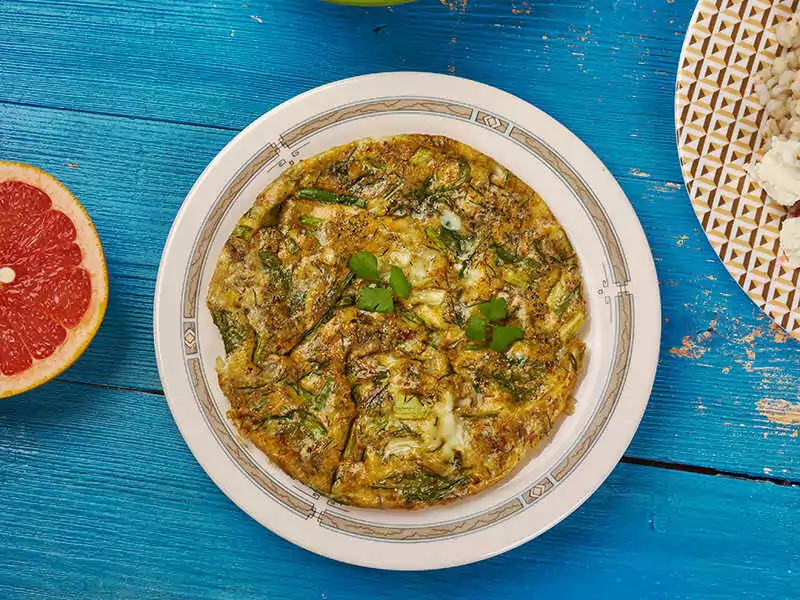
Feast your eyes on Eggah, Egypt’s delightful spin on the classic frittata, a dish made primarily from eggs. This versatile meal is widely adored across Egypt and the Levant, showcasing its popularity throughout these vibrant regions.
Eggah boasts an appetizing blend of eggs mixed with an assortment of vegetables, such as onions, spinach, zucchini, tomatoes, and leeks.
To elevate the flavors, this mixture is seasoned with a variety of spices, including cumin, turmeric, cinnamon, and nutmeg, alongside fresh herbs. The result is a thick and dense baked omelette that can be enjoyed at any time of the day.
Although it may appear to be a breakfast dish, Eggah transcends mealtimes, making it the perfect choice for an appetizer or main course.
To complete the dining experience, Egyptians often serve Eggah with salad, pita bread, and an assortment of side dishes, providing a true taste of Middle Eastern cuisine.
18. Shakshouka or Shakshuka
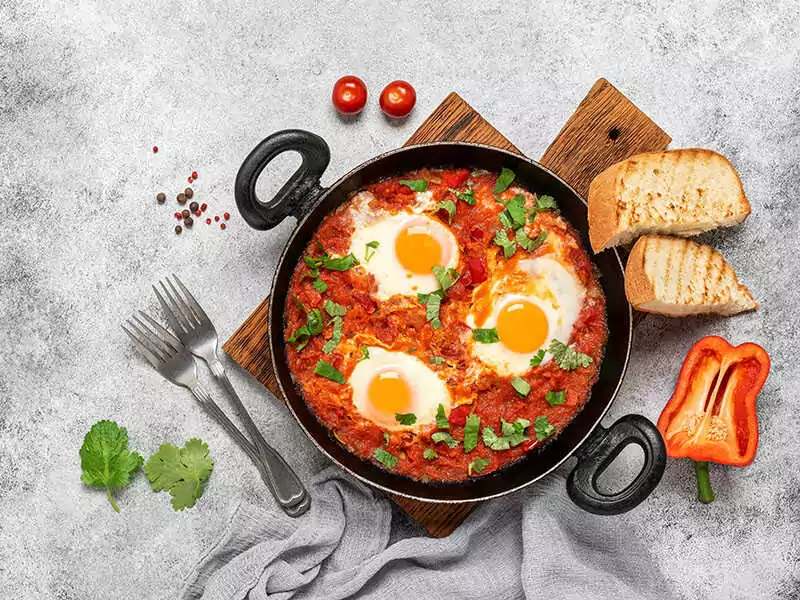
Shakshouka is an internationally renowned North African dish with an intriguing history dating back to the mid-16th century. This sumptuous meal, likely originating in Tunisia, boasts a fascinating blend of flavors brought together by the Columbian exchange, such as tomatoes and peppers.
Savor the taste of eggs poached in a mouthwatering tomato sauce infused with garlic, bell peppers, onions, green pepper, and olive oil.
Shakshouka entices your palate with a burst of herbs and spices like paprika, mint, parsley, coriander, and cumin. Its Arabic name, meaning “shaken together” or “mixed,” perfectly captures the essence of this one-skillet dish.
Traditionally a vegetarian meal, Shakshouka can be enjoyed at any time of day, though it is particularly popular as a breakfast or brunch choice in Israel. Pair it with flatbread and salad or indulge in a mezze platter complete with hummus, falafel, and other scrumptious Egyptian dishes.
For those seeking variety, Shakshouka can also be prepared with meat such as ground beef or lamb, or even in a green variation that swaps tomatoes for leafy vegetables like spinach, collard greens, kale, and brussel sprouts.
19. Feseekh
(Fermented and Salted Fish)
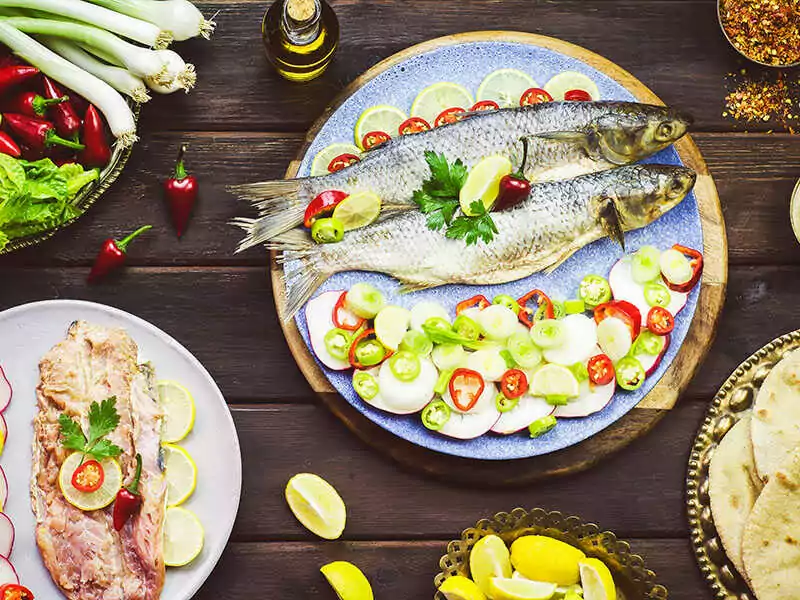
Feseekh is a time-honored Egyptian dish featuring salted and fermented mullet fish, often accompanied by herring, pita bread, and green onions. Its distinctive taste, which some may find pungent, makes it a somewhat controversial dish.
Despite this, it remains an integral part of Egypt’s Sham El-Nessim national day, a vibrant spring celebration with ancient origins. The festivities evoke similarities to Christian Easter traditions, with families customizing and displaying colorful eggs.
On this special occasion, many households delight in serving Feseekh, showcasing their connection to Egypt’s rich history and culture.
Desserts
Which one will be your favorite among thousands of Egyptian dessert recipes? Here are some of the most common and mouth-watering desserts in Egypt that will surely surprise you with their tastiness!
20. Konafa
(Cake)
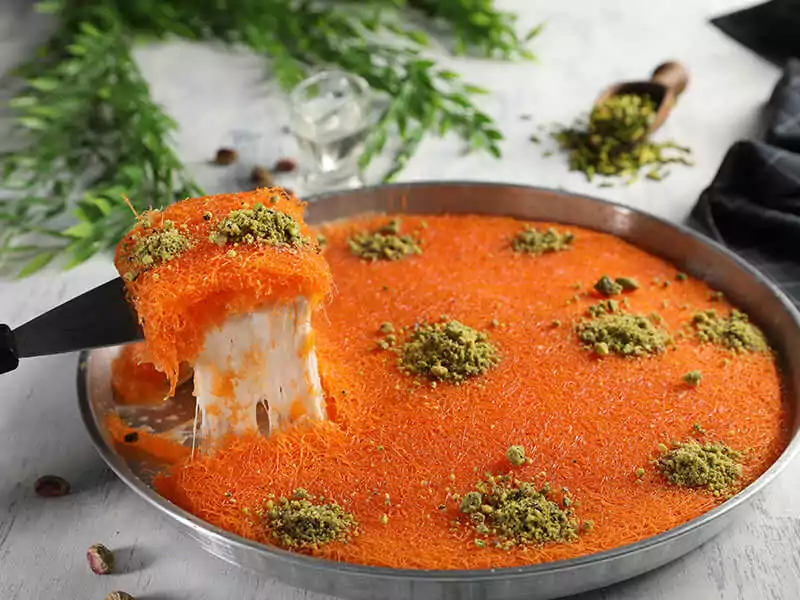
Konafa, a dessert cherished across Egypt, has captured the hearts and taste buds of many. This scrumptious sweet is particularly popular during the month of Ramadan.
Featuring shredded phyllo pastry layers filled with either cheese or cream, Konafa is a mouthwatering treat that comes in various sizes, from individual portions to large pans cut into smaller servings.
When in Egypt, don’t miss out on savoring a serving of steaming hot Konafa, where the gooey interior will have you craving more.
To elevate this heavenly dessert even further, it’s soaked in rose water or orange blossom water-infused syrup and often garnished with crushed pistachios and clotted cream.
Although its origins are unknown, this beloved Middle Eastern pastry is a true representative of the region’s diverse flavors. Pair your Konafa with a warm cup of mint tea for the ultimate culinary experience, as you indulge in a dessert that transcends borders.
You’ll be surprised to know that there are also a lot of Konafa variations. Some of them can be found in Syria, Greece, or the Balkans, with one notable example being Bulgarian cuisine. The Syrian edition of Konafa is called Künefe with a unique semi-soft cheese made from raw milk.
21. Umm Ali
(Bread Pudding)
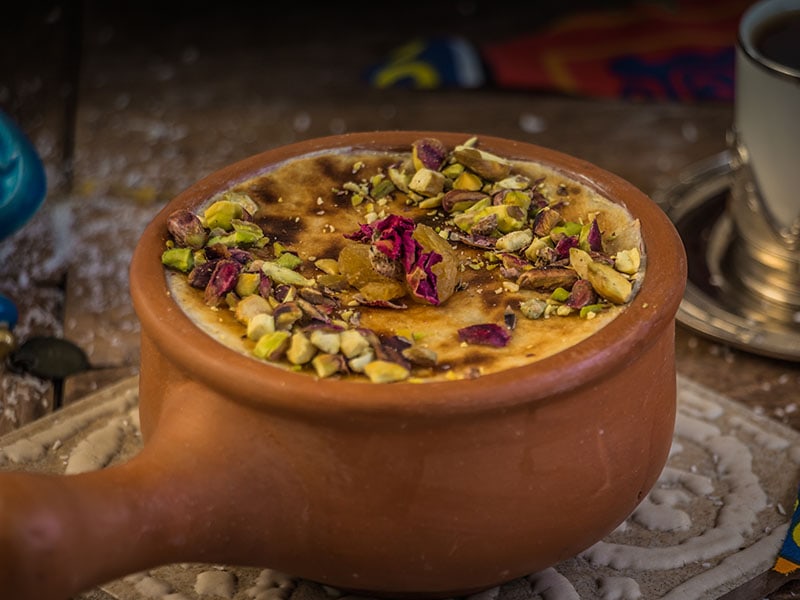
Also known as Om Ali, Omali, Umm Ali, or Oumm Ali, the name of this dish means “Mother of Ali”. It boasts a rich history, with its origins dating back to the medieval era in Egypt.
Named after the wife of Sultan Ezz El Din Aybak, Umm Ali was originally created in the 13th century as a victorious celebration dish.
Often seen at Egyptian weddings, this national treasure is Egypt’s unique take on bread pudding. With baked puff pastry or bread as its base, Umm Ali is soaked in a mixture of milk and sugar, resulting in a lighter, milkier texture compared to traditional bread puddings.
The absence of eggs in this recipe further sets it apart, allowing the dessert’s tasty flavors to shine through.
As you dive into a serving of Umm Ali, you’ll be treated to a blend of nuts, raisins, coconut pieces, and butter, topped with whipped cream for an indulgent experience.
Umm Ali is not only popular in Egypt alone. If you ever have the chance to explore African cuisine and its luscious desserts, you’ll definitely come across Umm Ali at least once.
22. Feteer Meshaltet
(Layered Pastry)
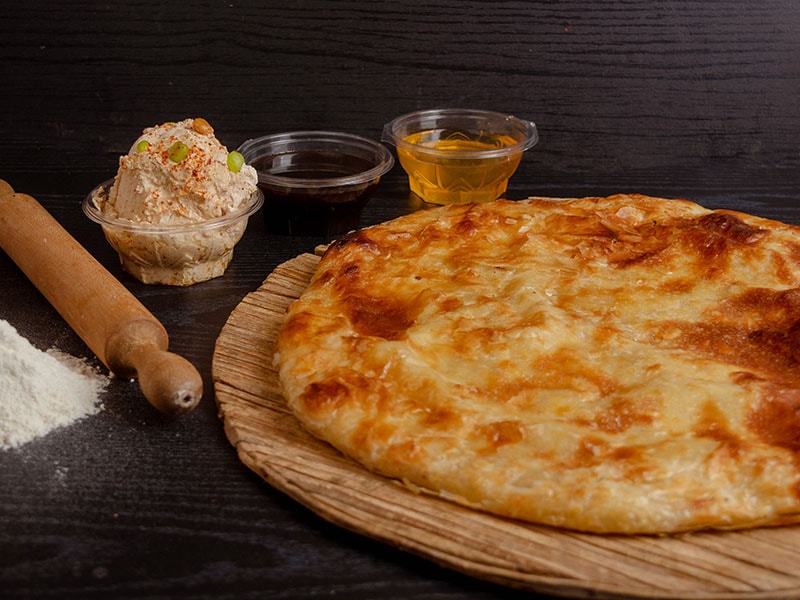
Feteer Meshaltet is the name of the Egyptian version of pie or pizza. It contains many dough layers topped with thousand options of toppings with sweet (coconut, nutella, chocolate, syrup, honey, sugar) or savory (minced meats, cheese, vegetables) flavors.
In Egypt, this dessert is an iconic symbol of hospitality that Egyptian families usually give as a gift to their loved ones or visitors. During the former U.S. President Barack Obama’s visit to Egypt in 2009, Feteer Meshaltet was also the sweet treat Egyptians served him.
Feteer Meshaltet may not suit those who don’t like fatty foods because this dish is super buttery! You will meet it at special celebrations of Egyptians such as weddings and holidays. Feteer is also the perfect gift from Egyptian families to their beloved ones or visitors.
23. Meshabek
(Funnel Cake)
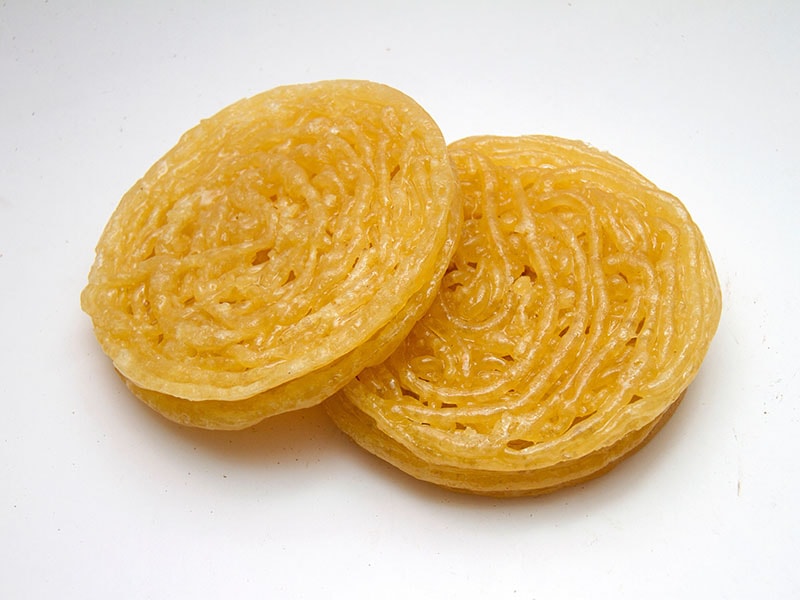
Meshabek is a super sweet dessert in a round, tube-like shape. You can find it everywhere in Egypt! The prepared dough containing flour, cornstarch, sugar, and oil is hand-crafted into a twisted spiral shape and deep-fried in hot oil.
This sweet dessert originates from Damietta and Tanta; later on, it has become viral in Egypt. Meshabek is a bit chewy and can be served with honey as a dipping sauce. It is also an affordable snack in this country.
24. Qatayef or Katayef
(Mini Pancakes)
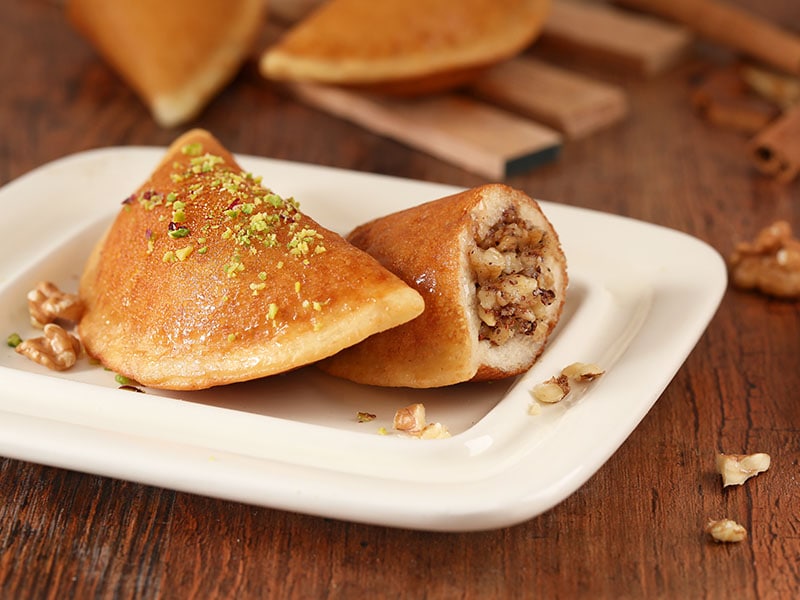
Qatayef, or Katayef, is the pancake version of Egyptians. With Konafa, Qatayef is a Ramadan dessert that will show up on the dinner table this holy month. This dish includes mini deep-fried semolina-yeast pancakes filled with cream and nuts.
It will captivate your senses with a delicate, golden exterior that enfolds a luscious filling of velvety sweet cheese and a medley of crunchy nuts. In contrast to their western counterparts, these Arabic pancakes are cooked exclusively on one side, resulting in a unique, tender texture.
The ancient Qatayef recipe was in a cookbook from the Abbasid Caliphate era. Nowadays, it has developed to a new version with the cooking process like pancakes, but for Qatayef, the cook only fries one side of it, then stuff and serves it with some sweet treats like honey.
25. Basbousa
(Coconut Yogurt Semolina Cake)
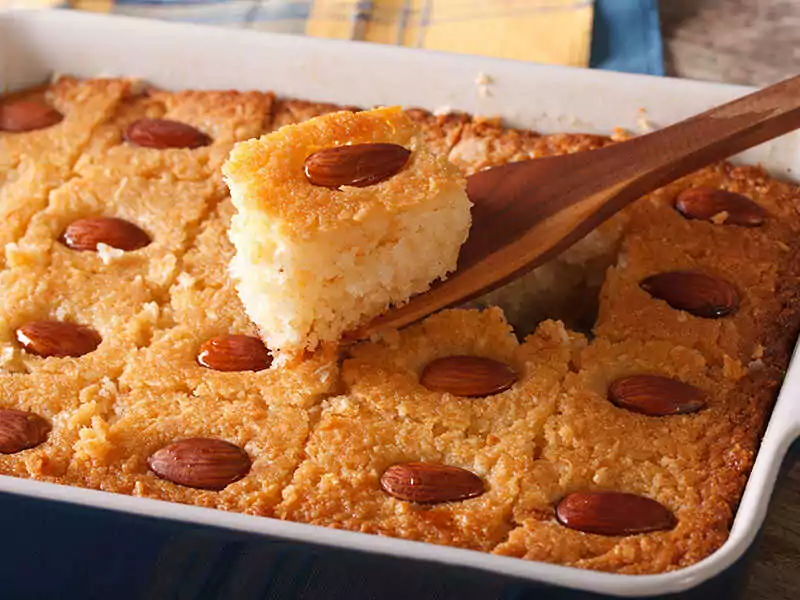
Basbousa is a ubiquitous dessert in Egypt. It is also a well-known sweet treat in Libya, Greek, Turkey, and other countries across North Africa, the Middle East, and the Balkans.
This heartwarming Egyptian dessert brings together the rich flavors of semolina, yogurt, and coconut. This irresistible confection derives its luscious sweetness from a unique syrup infused with the enchanting essences of orange flowers or rose extract.
To complete the experience, a lavish sprinkling of nuts such as pistachios and almonds crowns this exquisite treat.
In Egypt, the term “Basbousa” is synonymous with affection, as it’s commonly used by family members to lovingly refer to their dear ones. Mothers might affectionately call their daughters “my basbousa,” akin to “my love” or “my baby” in English.
With its strong ties to family and love, this special dessert has become a cherished part of Egyptian culture. Basbousa is a celebrated semolina cake that can be found in every Egyptian bakery.
Each establishment takes pride in its own secret recipe, while countless homemade variations continue to delight families across the region.
Additionally, it also boasts widespread appeal throughout the Middle East, North Africa, and the Balkans. While Basbousa may bear a resemblance to Revani (or Ravani), a similar semolina cake made with eggs and flour, it is important not to confuse the two.
26. Roz Bel Laban
(Egyptian Rice Pudding)
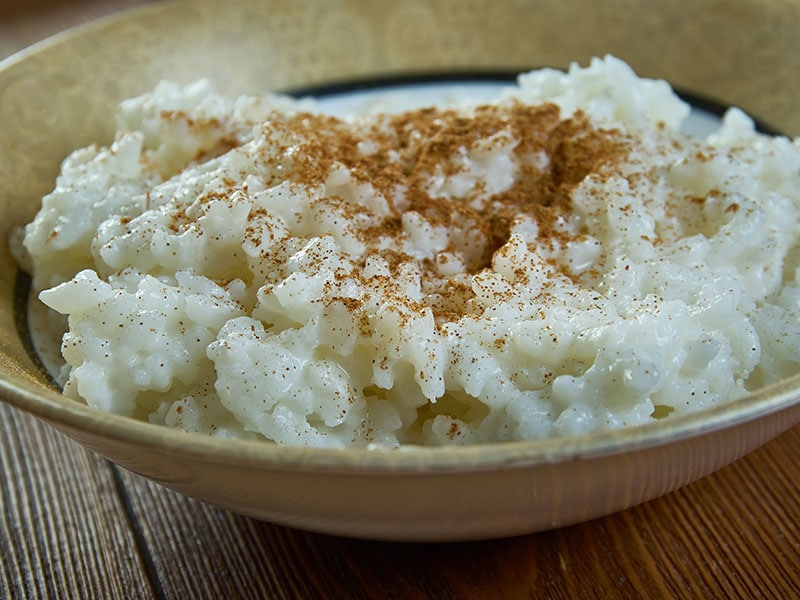
Roz Bel Laban, or Ros Bil Laban, is literally rice pudding in Egyptian old-fashioned style. It includes short-grain rice, rose water, butter, milk, vanilla, cinnamon, nutmeg, and sugar. Egyptians usually serve this delectable dessert warm or cold with hot mint tea.
For a perfect final look and taste, Roz Bel Laban will have some raisins or chopped nuts on top. Besides serving as a dessert, Egyptians will also eat this dish in the morning for breakfast or as a snack whenever they like!
27. Ghorayeba
(Egyptian Butter Cookie)
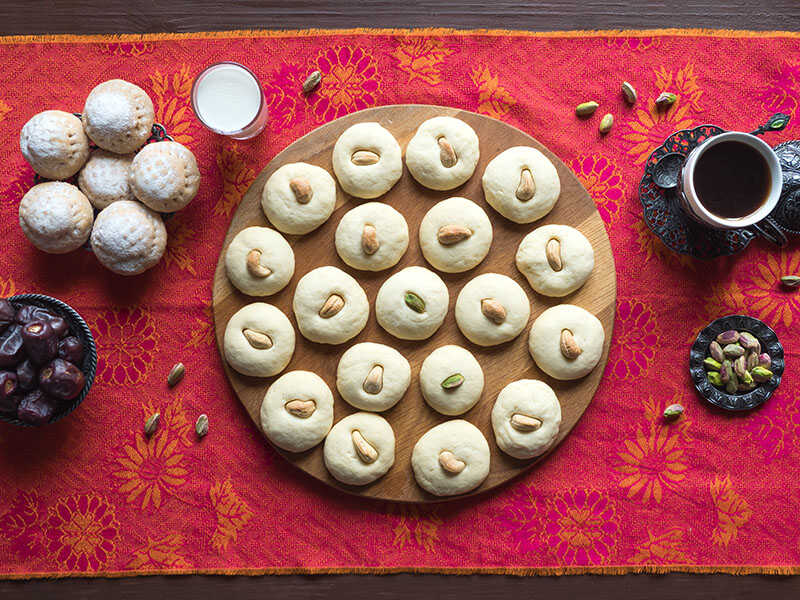
Ghorayeba, also called Ghraybeh or Ghoraybeh, is made from three common ingredients: flour, ghee, and sugar in powder form.
After baking the Ghorayeba dough, the cook will decorate the cookies with nuts on top. The most typically used nut types are almonds, cashews, and pistachios. Other versions of these sweet treats are famous in Syria or Lebanon, where people flavor them with rose or orange flower water.
In Egypt, they’re shortbread cookies that the locals will serve on essential occasions such as Christmas or Easter.
These divine cookies, often adorned with a selection of nuts like pistachios, almonds, or cashews, bring a touch of elegance to any gathering, making them an ideal treat to share with family and friends.
28. Baklava
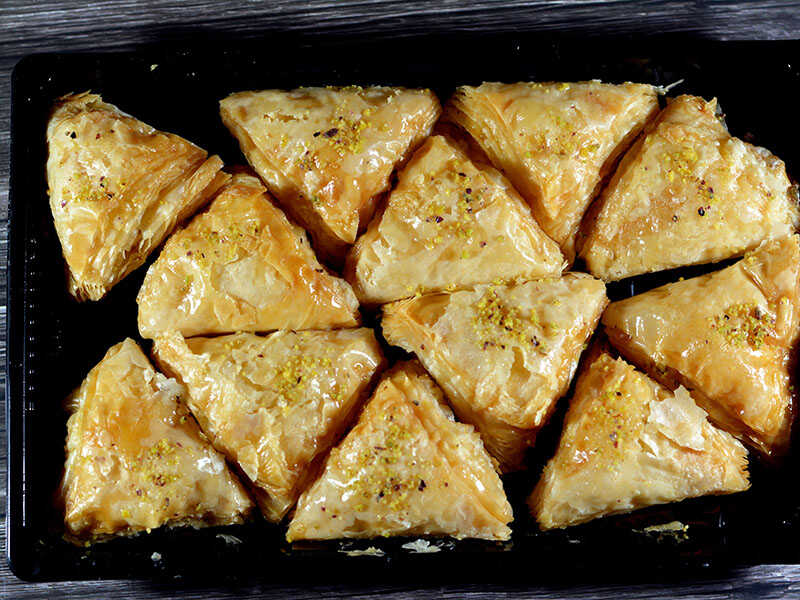
Behold Baklava is a Mediterranean masterpiece that has conquered taste buds across Egypt, Turkey, Greece, Iran, and beyond. This scrumptious dessert shares the spotlight with Kunafa, and both are known for their signature layers of delicate phyllo pastry.
A concoction of textures and flavors, Baklava features crispy sheets of phyllo pastry meticulously arranged with a medley of chopped nuts, including pistachios, walnuts, and hazelnuts, accompanied by rich butter and aromatic spices.
Prior to baking, this heavenly dessert is cut into enticing rectangles or diamonds and then adorned with a syrup infused with honey, rose water, or orange blossom water. The origins of Baklava may be shrouded in mystery, but its present incarnation is believed to have emerged from the esteemed kitchens of the Ottoman Empire.
Today, this tempting treat can be found gracing the tables of Turkish, Iranian, and Arab cuisines, as well as those in the Levant, Maghreb, Somalia, the Balkans, South Caucasus, and Central Asia.
Baklava, a sweet and nutty indulgence, effortlessly elevates any gathering or special occasion. While the process of crafting this pastry may be labor-intensive, the outcome is undeniably worth the effort.
29. Kahk or Ka’ak al-Eid

Kahk el-Eid is the delicious Egyptian biscuit that unites cultures and flavors in a sweet celebration! These small, circular treats are dusted with powdered sugar and traditionally savored during Eid al-Fitr, marking the end of Ramadan.
From ancient Egypt to present-day festivities, Kahk has been an essential part of special occasions, including Easter, Christmas, and weddings, cherished by both Muslims and Christians.
Kahk’s melt-in-your-mouth texture is achieved with a generous helping of ghee, creating a brittle yet deliciously delicate experience. Each biscuit can be enjoyed plain or adorned with ornamental patterns and designs, a custom that has its roots in ancient Egyptian culture.
These intricate imprints often tell stories and carry significant meanings, making every Kahk a piece of edible art.
Bite into a Kahk, and you’ll discover an array of delightful fillings – from date paste and walnuts to agameya, a scrumptious concoction of honey, nuts, and ghee. You may even encounter Kahk with a blend of agameya and walnuts, offering a satisfying fusion of flavors.
In times long past, the ancient Egyptians also crafted pie-sized versions of Kahk, known as shurik, which they brought along during visits to their ancestors’ tombs. These large, ornate biscuits were believed to serve as magical amulets, protecting and guiding the departed on their journey.
From its origins as a symbol of ancient Egyptian rituals to its prominent role in modern celebrations, Kahk el-Eid has stood the test of time.
Drinks
If you are wondering what to drink in Egypt after a big meal, this section is for you! I have listed here the most refreshing and healthy beverages, so take a look and find yourself the best Egyptian drink ever!
30. Egyptian Tea
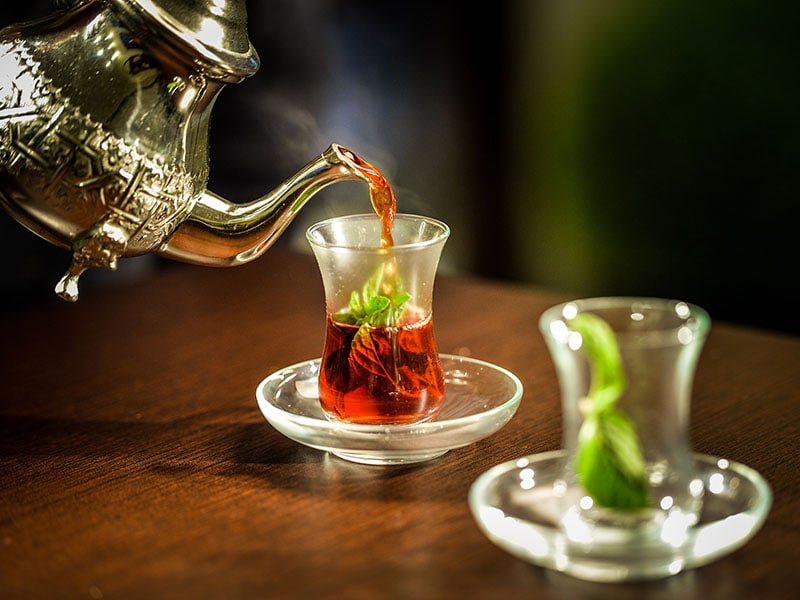
Tea is undoubtedly the most typical beverage in Egypt because tea is an essential part of Egyptians daily life!
There are thousands of types and flavors of Egyptian teas that will certainly astonish the teaholics! The most common tea here is black tea with various ways of preparation.
Another famous tea type in Egypt is herbal teas from plant leaves. Hibiscus tea and mint tea are the two most well-known variations in Egypt’s tea-drinking culture. They can be mixed with lemonades or black teas to get the best blending taste.
31. Sahlab
(Egyptian Warm Milk)
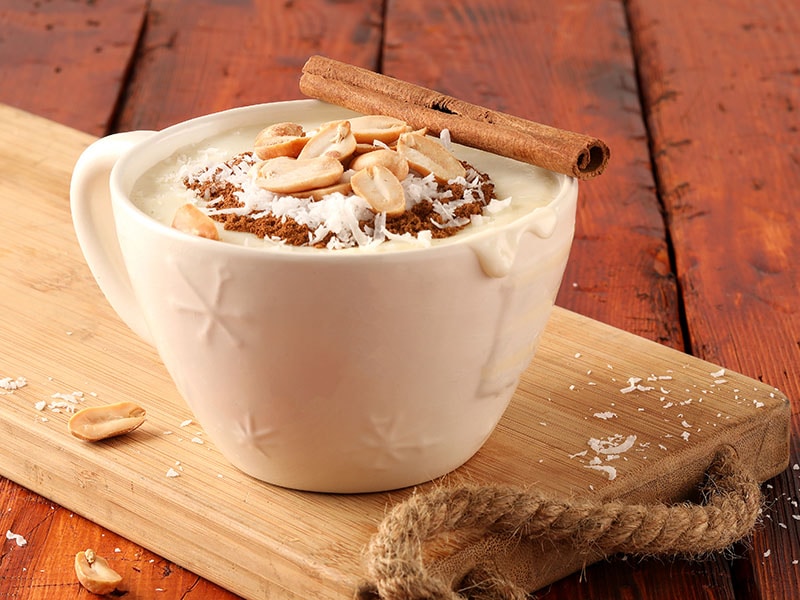
Sahlab is the name of warm Egyptian milk, whose base is from milk mixed with orchid root powder. Unlike other milk varieties, Sahlab has a unique thickness from the root powder. The milk base and more ingredients like vanilla and cinnamon are kept in instant sachets.
Egyptians usually drink Sahlab during winter for breakfast or after lunch. Ancient Romans even considered Sahlab a strong aphrodisiac or fattener for young women in the Ottoman Empire before their marriage.
When you want to drink Sahlab, just dip the sachets in warm milk and let it dissolve. Then, you can top it with some favorite fruits like berries and bananas. The traditional Sahlab will have shredded coconut, pistachio, cinnamon, and raisins. Sounds delicious, right?
You can quickly make yourself a cup of Sahlab with instant milk powder!
32. Egyptian Sobia Drink
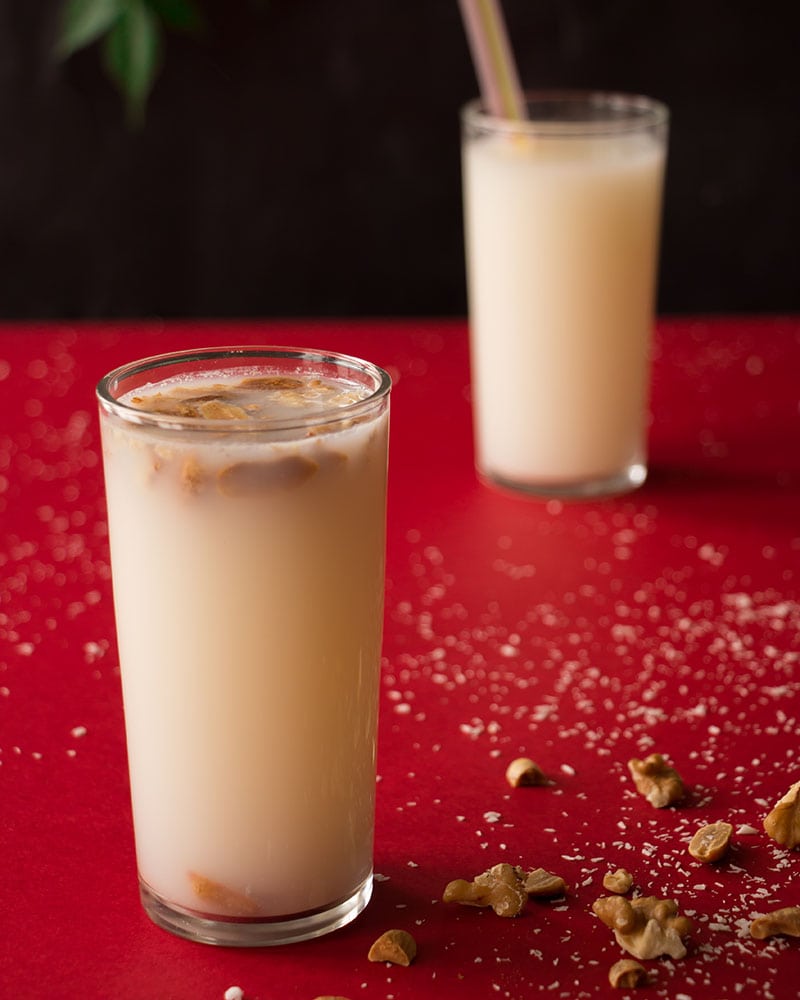
Sobia is a traditional drink from rice, dairy products, coconut milk or powder, vanilla, and sugar in Egypt. Egyptians will serve it cold with crushed ice. Sobia is creamy, rich in flavors, and thick texture; therefore, some people also consider it a dessert.
This drink is also a yummy treat for children. Like sahlab, Egyptians are likely to produce it into an instant powder that is very convenient to use. The locals sometimes mix Sobia with strawberry or mango juices to make a unique drink!
FAQs
Curious about the nuances of Egyptian cuisine? The answer to the most frequently asked questions will satisfy your curiosity and ignite your appetite!
Discover Your New Egyptian Culinary Obsession
What can be your go-to treat when you visit Egypt? You may find these dishes in an Egyptian restaurant near your place, but it is always best to taste the originals right in Egypt! So if you have the chance to visit this beautiful country, don’t forget to explore its cuisine!
Hope that you have had a fun time reading this article about Egyptian foods! You can always hit the like, share button, or subscribe to the newsletter to get the latest news and information about this topic.
Also, if you have any questions or stories in your mind, don’t hesitate to tell me below this post through the comment section! Can’t wait to reply to you all! Thank you for reading, and hope to see you soon!
